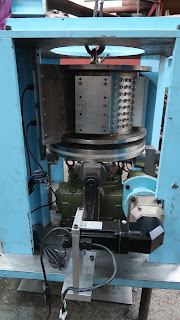Thanks to an internally funded collaborative project with the Engineering department, I get to spend some of my days hanging out at Carleton Lab on CU's main campus. In particular I get to spend time near this beast: a 5 meter-arm, 200 g geotechnical Centrifuge.
In particular, we will be making ice samples in this big steel cylinder that will sit atop a rotating rock base, in order to measure friction and bed evolution as a function of velocity, debris content, and normal stress, which is applied via g force in the centrifuge. The rig that will ride in the cage of the centrifuge was custom made in Taiwan and, after a string of unfortunate events, arrived late last spring.
I'll write much more about this new rig in months to come. There are a lot of tasks necessary to get it to maintain a low enough temperature to make and keep ice, to measure normal load (at 1 g) and torque, to ultimately measure and control pore pressure in the melt that will form at the interface... Lots to do.
I was wiring up thermocouples the other day and I had a treat. Visiting graduate student Hsiu-Chuan Hsu was running some of his slope collapse experiments in the centrifuge. He loaded up the transparent beads in silicon oil in a very high tech fish tank in the centrifuge cage. Liming closed the very heavy, very thick safety door of the centrifuge room.
Then from the control panel they started cranking up the g.
Look at it go!





